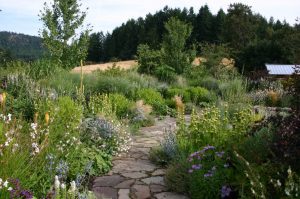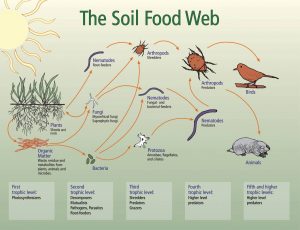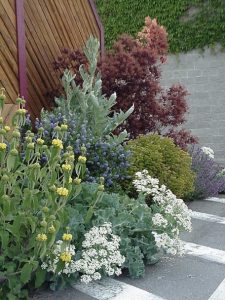Five Ways to Create an Abundant Landscape
There is nothing quite like witnessing abundance in your landscape. What do we mean when we refer to a landscape as abundant? Here’s one definition, a profusion, a great plenty, an overflowing quantity.
How do we take our existing landscapes, which are often compacted, lack organic matter and soil life and shift these into abundant spaces? Nature is the center of abundance, and it’s here that we can learn and apply this knowledge to our landscapes. Like many things in life, the answers are quite simple.
Let’s take a look at five ways you can shift your landscape:
- Hold, slow and sink the water that travels through your site – We are very fortunate to live in an area of the world that receives a healthy amount of rainfall, especially during the winter months (average annual rainfall in Nanaimo is around 1063mm). The amount of rain that falls on an average size lot exceeds the amount of water required to keep the landscape hydrated. So why do we have to irrigate our landscapes during the dry summer months? One reason is the timing of the rain events. If you look at the rainfall and temperature graph below, you’ll see that our warmest months are also our driest. When looking at how we build our communities, you can see we tend to drain excess water during the winter and then pump in water in the growing season when rains subside. One of the best strategies one can employ on our property is to hold or slow the movement of water across the landscape. As the water slows, it will increase the rate of infiltration into your soils. This practice can help provide moisture during the dryer months of the year. You can see some specific strategies in a previous blog linked here.
- Identify and optimize microclimates on your site – Your landscape might be somewhat open and hot, or perhaps you live around some large trees which cast shade. Whatever your situation, your site will contain some microclimates which may be specific to a small location within your property. An example might be a planting area right next to a hot south-facing wall or a cool shady location on the north side of your house. These various microclimates are essential to identify so that you optimize your plantings and increase your yield or results.
- Cultivate your soil, not your plants – All we need to do is look after our soils and the plants will take care of themselves. Soil organisms drive the nutrient cycle within our soils, if you wish to increase the vitality of your plants, then look no further than your soils.
- Research your plant choices before purchasing – It is time well spent when you research plants that you would like to see in your garden versus the impulse purchase at your local nursery. Look to incorporate plants that provide you with more than just an aesthetic punch. There is a wide range of lovely plants which will offer more than just good looks but also edible, or medicinal characteristics. Plants that can provide you or your landscape with other needs such as pollinator support, biomass or fibre are worth considering.
- Integrate rather than segregate – By placing the right things in the right place, relationships develop between them, and they support each other. When you integrate elements into your landscape you create a greater level of resilience which can express itself in times of extreme weather. This approach to designing is not a new one; many indigenous tribes or groups around the world have been practicing these methods for centuries. Here’s an excellent definition of permaculture from Andrew Millison’s Introduction to Permaculture e-book.
“Permaculture design is a method of landscape planning that can be applied at scales from the home garden to city block to the village to farm. It is an ethically based whole-systems design approach that uses concepts, principles, and methods derived from ecosystems, indigenous peoples, and other time-tested practices to create sustainable human settlements and institutions. Although rooted in horticulture and agriculture, Permaculture design is interdisciplinary, touching on a wide range of subjects including regional planning, ecology, animal husbandry, appropriate technology, architecture, and international development.”…
“A system is defined as “a set of connected things or parts forming a complex whole.” So when we refer to water systems, we’re recognizing that the way we design for water on a Permaculture site takes into account its’ many interconnections, with soils, trees, water tables, the atmosphere, and wildlife.”
If you are interested in further exploring permaculture design be sure to check out Oregon State University’s free online introduction to permaculture course. For design services feel free to check out our services page or book an appointment to chat about your landscape goals.
Jamie Wallace
Co-owner of Jaan Designs
Permaculture Designer, Educator






